Without fail, food is one topic guaranteed to pop up whenever I talk to people back home. Even though I’ve discussed a few different types of Korean foods in previous posts I thought it was about time to put these wonderfully delicious concoctions together (with pictures!) for everyone in the Western Hemisphere to get an idea of what I ingest everyday. Panda Express this is not; this is Korean food.
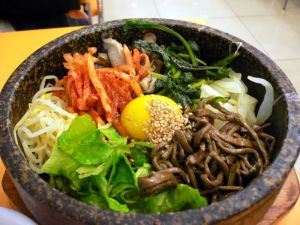 Bibimbap is essentially a Korean take on salad. It’s initially just a bowl full of vegetables and rice with an egg on top, but before bibimbap is eaten, a healthy dose of hot sauce is added. The rice on the bottom of the bowl is mixed up with the vegetables on top and everything gets blissfully covered in the red chili sauce. The hot sauce is really what makes this dish one of my favorites, and an after-work omnipresence in my diet. I’m still not entirely sure what this sauce is but it’s thankfully in quite a few Korean dishes.
Bibimbap is essentially a Korean take on salad. It’s initially just a bowl full of vegetables and rice with an egg on top, but before bibimbap is eaten, a healthy dose of hot sauce is added. The rice on the bottom of the bowl is mixed up with the vegetables on top and everything gets blissfully covered in the red chili sauce. The hot sauce is really what makes this dish one of my favorites, and an after-work omnipresence in my diet. I’m still not entirely sure what this sauce is but it’s thankfully in quite a few Korean dishes.
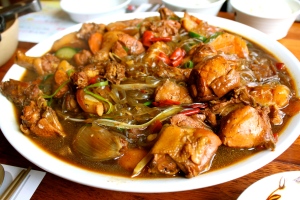 Jjimdak is far and away my favorite Korean food. This spicy noodle dish is served communally, a common practice at restaurants in Korea. Jjimdak is made up of a layer of noodles topped with chicken, potatoes, carrots, onions, peppers, cucumbers, and various other stringy green vegetables, all smothered in a spicy brown sauce. If I have one complaint about a lot of Korean food it’s that the abundance of leafy vegetables oftentimes leaves you less than completely satisfied. Jjimdak is hearty and filling and lately it seems as though I’ve been going to get it at least once a week, not that I’m complaining.
Jjimdak is far and away my favorite Korean food. This spicy noodle dish is served communally, a common practice at restaurants in Korea. Jjimdak is made up of a layer of noodles topped with chicken, potatoes, carrots, onions, peppers, cucumbers, and various other stringy green vegetables, all smothered in a spicy brown sauce. If I have one complaint about a lot of Korean food it’s that the abundance of leafy vegetables oftentimes leaves you less than completely satisfied. Jjimdak is hearty and filling and lately it seems as though I’ve been going to get it at least once a week, not that I’m complaining.
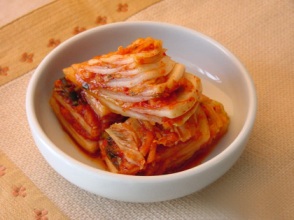 To say that kimchi is a staple of Korean food is one of the biggest understatements in the history of the world. Koreans eat kimchi with every meal seven days a week, 365 days a year. Kimchi is fermented cabbage covered in a brine-based spicy pepper sauce that has been sitting in pots underground for months. Sounds appetizing, right? I’m not going to lie, when I first tried kimchi I was less than impressed. Cabbage and brine aren’t high on the list of my most favorite flavors in the world. As time goes by, however, kimchi keeps tasting better and now it is a spicy welcome to every meal rather than the lump of fishy cabbage on the side of my plate.
To say that kimchi is a staple of Korean food is one of the biggest understatements in the history of the world. Koreans eat kimchi with every meal seven days a week, 365 days a year. Kimchi is fermented cabbage covered in a brine-based spicy pepper sauce that has been sitting in pots underground for months. Sounds appetizing, right? I’m not going to lie, when I first tried kimchi I was less than impressed. Cabbage and brine aren’t high on the list of my most favorite flavors in the world. As time goes by, however, kimchi keeps tasting better and now it is a spicy welcome to every meal rather than the lump of fishy cabbage on the side of my plate.
 While makgoelli technically isn’t a food, it’s so amazing I don’t really care and I’m going to put it on the list anyway. This is a rice wine that looks more like milk than anything else. Thankfully, though, this wondrous drink is not milk: it’s alcohol! Makgoelli is about the same strength as the wine we know back home so it’s not like drinking vodka or whiskey. Makgoelli has a little trace of rice flavor, and as odd as that sounds it actually makes this a sweeter, more refreshing drink. It is traditionally served in bowls rather than cups and has to be shaken before it is poured so the grainy bits stay at the bottom rather than get dumped into your glass. This is one alcoholic drink that doesn’t need to have alcohol to enjoy. I would drink this like a bottle of pop even without the resulting (mild) inebriation. That’s just a bonus.
While makgoelli technically isn’t a food, it’s so amazing I don’t really care and I’m going to put it on the list anyway. This is a rice wine that looks more like milk than anything else. Thankfully, though, this wondrous drink is not milk: it’s alcohol! Makgoelli is about the same strength as the wine we know back home so it’s not like drinking vodka or whiskey. Makgoelli has a little trace of rice flavor, and as odd as that sounds it actually makes this a sweeter, more refreshing drink. It is traditionally served in bowls rather than cups and has to be shaken before it is poured so the grainy bits stay at the bottom rather than get dumped into your glass. This is one alcoholic drink that doesn’t need to have alcohol to enjoy. I would drink this like a bottle of pop even without the resulting (mild) inebriation. That’s just a bonus.
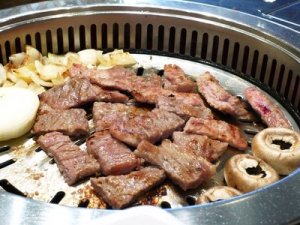 Whenever you hear about Korean barbeque, chances are you are hearing about galbi. Galbi is marinated beef strips cooked on a miniature grill in the middle of the table at a restaurant. The strips of beef are put in leaves of lettuce, topped with various vegetables and sauces, and eaten like little lettuce tacos. Galbi is served with a seemingly endless array of banchan, or side dishes. These side dishes are refillable, served communally, and completely free with dinner. Galbi is DIY-style Korean dining at its best.
Whenever you hear about Korean barbeque, chances are you are hearing about galbi. Galbi is marinated beef strips cooked on a miniature grill in the middle of the table at a restaurant. The strips of beef are put in leaves of lettuce, topped with various vegetables and sauces, and eaten like little lettuce tacos. Galbi is served with a seemingly endless array of banchan, or side dishes. These side dishes are refillable, served communally, and completely free with dinner. Galbi is DIY-style Korean dining at its best.
 Dukbokki is a very popular Korean street food. This dish is made of rice cakes covered in a spicy pepper sauce (see a common trend in Korean cuisine?), sometimes with little fish cakes thrown in as well. There is a dukbokki shop across the street from my work and this is a fairly common lunch of mine. Like with my feelings towards kimchi, it took a while for me to appreciate dukbokki. It can be pretty spicy at times, which I love, but the spicy kick with a sometimes fishy aftertaste wasn’t love at first bite. Now I know how to avoid the fish cakes and enjoy the spicy noodles just as they are.
Dukbokki is a very popular Korean street food. This dish is made of rice cakes covered in a spicy pepper sauce (see a common trend in Korean cuisine?), sometimes with little fish cakes thrown in as well. There is a dukbokki shop across the street from my work and this is a fairly common lunch of mine. Like with my feelings towards kimchi, it took a while for me to appreciate dukbokki. It can be pretty spicy at times, which I love, but the spicy kick with a sometimes fishy aftertaste wasn’t love at first bite. Now I know how to avoid the fish cakes and enjoy the spicy noodles just as they are.
 Like makgoelli, soju really isn’t food but, it is just as much of an integral part of Korean cuisine as kimchi is so to not put it on a list of the best Korean foods would be a sacrament to everything that is Korean. Unlike the heaven in a cup that is makgoelli, soju is pure hell. It’s a hangover-inducing drink that really just tastes like vodka mixed with water. The real redeeming quality about soju is its price. A bottle of this is about $1 and that is enough to keep you happy for the rest of the night. Koreans drink soju like water and I’ve seen many a table at restaurants with three or four ajushis (old men) and five or six empty soju bottles. I may not be a fan of its taste but I do appreciate a good bargain whenever I find one and an entire night’s worth of drinks for chump change is nothing to sneer at.
Like makgoelli, soju really isn’t food but, it is just as much of an integral part of Korean cuisine as kimchi is so to not put it on a list of the best Korean foods would be a sacrament to everything that is Korean. Unlike the heaven in a cup that is makgoelli, soju is pure hell. It’s a hangover-inducing drink that really just tastes like vodka mixed with water. The real redeeming quality about soju is its price. A bottle of this is about $1 and that is enough to keep you happy for the rest of the night. Koreans drink soju like water and I’ve seen many a table at restaurants with three or four ajushis (old men) and five or six empty soju bottles. I may not be a fan of its taste but I do appreciate a good bargain whenever I find one and an entire night’s worth of drinks for chump change is nothing to sneer at.
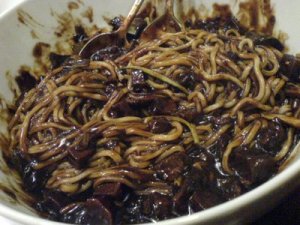 Jajangmyeon is Korea’s version of Chinese food, and a la General Tso’s chicken and the fortune cookie back the US, this is a completely foreign take on Chinese cuisine. Jajangmyeon consists of noodles covered in a thick, black, soybean-based sauce. It has various chunks in the sauce that get mixed up in the noodles and, to be completely honest, I’m not entirely sure what they are. Jajangmyeon may be Korean rather than Chinese-made but it still tastes different from almost all other Korean foods and given the astonishingly high amount of food covered in some sort of brine or pepper based sauce that’s reason enough to love this dish.
Jajangmyeon is Korea’s version of Chinese food, and a la General Tso’s chicken and the fortune cookie back the US, this is a completely foreign take on Chinese cuisine. Jajangmyeon consists of noodles covered in a thick, black, soybean-based sauce. It has various chunks in the sauce that get mixed up in the noodles and, to be completely honest, I’m not entirely sure what they are. Jajangmyeon may be Korean rather than Chinese-made but it still tastes different from almost all other Korean foods and given the astonishingly high amount of food covered in some sort of brine or pepper based sauce that’s reason enough to love this dish.

Great list, I could eat Dukbokki everyday for the rest of my life and still be happy.
I will be catering in January 2012 for a group of visiting South Korean college students. What do you think would be an appropriate menu? Introduction to typical American student food, Korean food, or American Melting pot menu, including mexican, italian, etc? I want them to enjoy their first taste of the US.
Jan